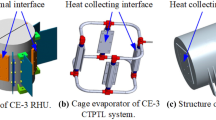Abstract
The space thermal environment of the remote sensor on the geostationary orbit is exceptionally harsh. It is necessary to carry out a high-precision thermal control design to realize the temperature uniformity and stability of core components such as the central optical and mechanism bodies. Sufficient ground tests must verify the correctness of the thermal control design. Accurate simulation of the space heat flow is the key to ensuring the adequacy and effectiveness of the ground thermal test. Considering the shortcomings of traditional space heat flow simulation methods, this paper proposes two advanced and high-precision space heat flow simulation methods, named combined heat flow simulation method based on a solar simulator and absorption heat flow simulation method based on the electric heater. The two methods have been verified based on the simulations and tests of the different size remote sensors. The results show that the two advanced simulation methods can meet the space heat flow simulation requirements. In addition, the accuracy, economy, and engineering feasibility of heat flow simulation are improved, and the high-precision simulation of the space heat flow for geostationary space remote sensors is realized.











Similar content being viewed by others
References
Bartera, R.E., Riise, H.N., Miller, C.G.: Solar Simulators at the Jet Propulsion Laboratory[J]. Appl. Opt. 9(5), 1068–1074 (1970)
Fan, H.L., Wen, Y.P.: Review on the thermal balance test for spacecraft[J]. Spacecraft Environment Engineering 24(2), 63–68 (2007)
Feng, Y., Nana, X., Yu, Z., et al.: Thermal Design and Test for High Resolution Space Camera on GF-4 Satellite[J]. Spacecraft Recovery & Remote Sensing. 37(4), 72–79 (2016)
Feng, Y.U., Bing, W.A.N.G., Zhenming, Z.H.A.O.: Influence of Solar Radiation Parameters on Optical Lens Thermal Design and Its Simulation Countermeasure[J]. Spacecraft Recovery & Remote Sensing. 34(2), 36–41 (2013)
Fengwei, G.U.A.N., Ju, L.I.U., Shanmeng, Y.U., et al.: Space Heat Flux Simulation and Programmable Load for Thermal Test of Space Optical Remote Sensor[J]. Chinese Optics 7(6), 982–988 (2014)
Fumoto, K., Sasa, M., Okabe, T., et al.: Research on Heat Transfer Performance of the Open-Loop Micro Pulsating Heat Pipe with Self-Rewetting Fluids. Microgravity Sci. Technol. 31, 261–268 (2019)
Guofan, J.I.N.: The New Development of Optical Technology[J]. Spacecraft Recovery & Remote Sensing 40(3), 1–4 (2019)
Koczor, R.J.: Technology needs for geostationary remote sensors, in: Proceedings of SPIE: Optical Engineering and Photonics in Aerospace Sensing, Orlando, FL, United States 134–140 (1952)
Mahmud, H., Ahmed, D.H.: Numerical Investigations on Melting of Phase Change Material (PCM) with Different Arrangements of Heat Source-sink Pairs Under Microgravity. Microgravity Sci. Technol. 34, 20 (2022)
Mameli, M., Marengo, M., Zinna, S.: Numerical Investigation of the Effects of Orientation and Gravity in a Closed Loop Pulsating Heat Pipe. Microgravity Sci. Technol. 24, 79–92 (2012)
Wang, Z., Yao, F.: Investigation on Transient Characteristics of Heat Pipe with Re-Entrant Grooved Wick. Microgravity Sci. Technol. 32, 521–529 (2020)
Wenbo, Q., Huier, C.: Study on Simulation of External Flux in Vacuum Thermal Test of Docking Mechanism[J]. AEROSPACE SHANGHAI 6, 47–51 (2008)
Yao, F., Bian, N., Xia, Y., et al.: Thermal Performance of an Axially Grooved Heat Pipe Subjected to Multiple Heating Sources. Microgravity Sci. Technol. 33, 8 (2021)
Zengqi, H.O.U., Jingang, H.U.: Spacecraft Thermal Control Technology: theory and application [M]. China Science and Technology Press, Beijing (2007)
Zurmehly, G.E., Hookman, R.A.: Thermal and structural design constraints for radiometers operating in geostationary orbits, in: Proceedings of SPIE: The Int Soc Optical Eng Orlando, FL, United States 304–312 (1992)
Author information
Authors and Affiliations
Corresponding author
Ethics declarations
Conflict of Interests
The authors have no relevant financial or non-financial interests to disclose. The authors have no competing interests to declare that are relevant to the content of this article. All authors certify that they have no affiliations with or involvement in any organization or entity with any financial interest or non-financial interest in the subject matter or materials discussed in this manuscript. The authors have no financial or proprietary interests in any material discussed in this article.
Additional information
Publisher's Note
Springer Nature remains neutral with regard to jurisdictional claims in published maps and institutional affiliations.
Rights and permissions
About this article
Cite this article
Feng, Y.U., Nana, X.U. & Ping, Z. Investigation of Space Heat Flow Simulation Methods for Light Entrance of the Remote Sensor on GEO. Microgravity Sci. Technol. 34, 51 (2022). https://doi.org/10.1007/s12217-022-09970-3
Received:
Accepted:
Published:
DOI: https://doi.org/10.1007/s12217-022-09970-3




